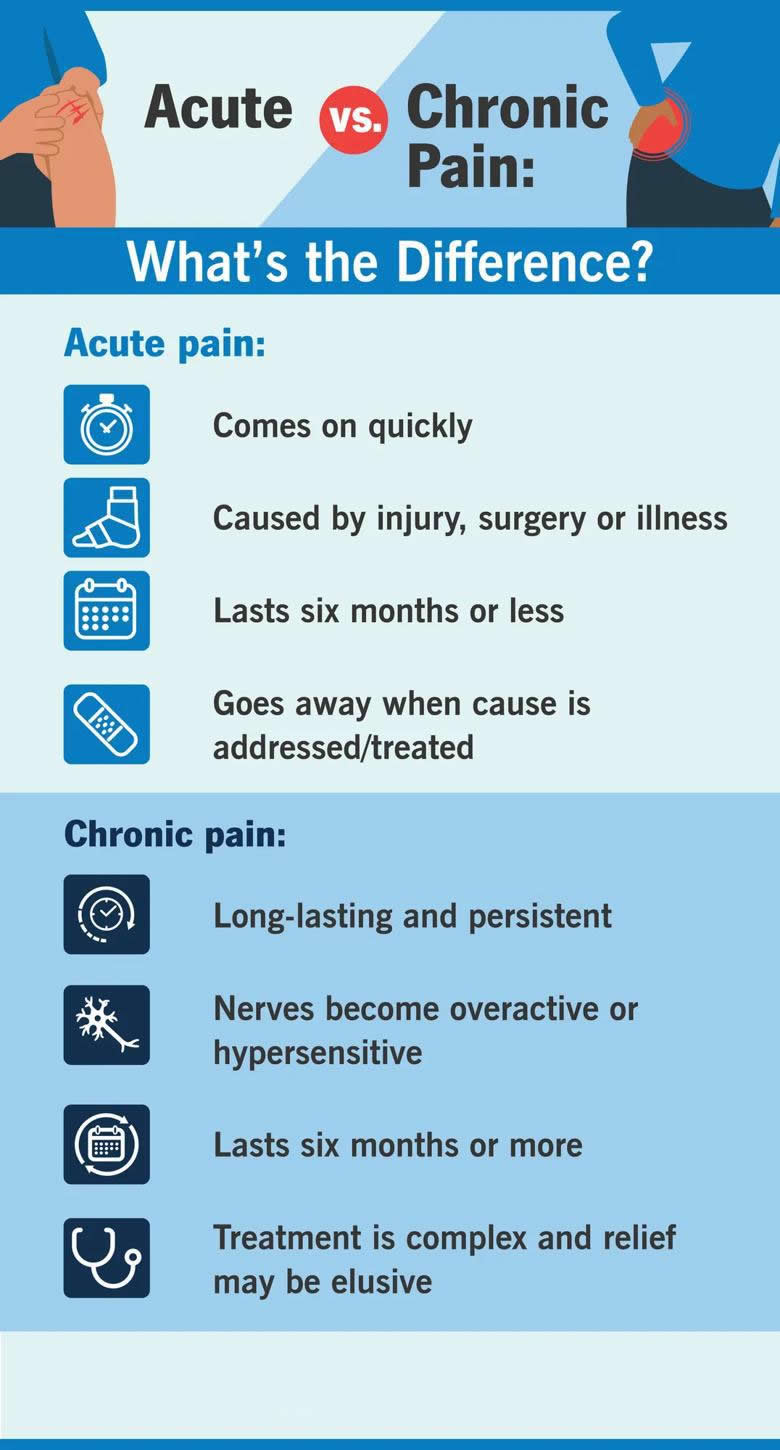What’s the Difference Between Acute and Chronic Pain?
Acute pain goes away with treatment, while chronic pain is long-lasting and can be complex to manage

Pain is a sign from your body that something is wrong. But there are different types of pain, starting with two major categories: acute and chronic. So, what’s what? Family medicine doctor Charles Garven, MD, explains.
Acute vs. chronic pain

Acute pain usually comes on suddenly and is caused by something specific. Chronic pain is ongoing and usually lasts longer than three to six months.
“I had a mentor once describe acute pain as a loud alarm in an emergency, like a broken leg. It’s your body warning you that something is wrong and needs to be addressed,” Dr. Garven illustrates.
“Chronic pain, then, is a broken alarm that keeps ringing — and it can sometimes keep ringing even if there’s no longer a fire burning.”
Let’s take a closer look at some of the differences between these two types of pain.
Acute pain
“Acute pain starts quickly and goes away once the issue is addressed or healed,” Dr. Garven explains.
This type of pain can last just a little while, like if you fall on the pavement and skin your knee, or it can last longer, like when you’re recovering from surgery.
Causes and examples
Some possible causes and examples of acute pain include:
- Broken bones
- Cuts, scrapes, bruises and burns
- Dental work
- Dislocated joints
- Headaches
- Illness-related pain, like a sore throat
- Kidney stones
- Labor and childbirth
- Surgery
Management
To treat acute pain, a healthcare provider will focus on managing whatever’s causing the pain. But as you can imagine, this means that treatment methods vary widely.
Here are a few common treatments for various types of acute pain:
- The RICE method:The acronym “RICE” stands for “rest, ice, compression and elevation.” It’s the first line of management for injuries like strains and sprains.
- Pain medication:Over-the-counter painkillers like acetaminophen (Tylenol®) and nonsteroidal anti-inflammatory drugs (NSAIDs) can help keep pain at bay. In some cases, prescription painkillers are appropriate for managing acute pain.
- Physical therapy:After surgery or an injury, physical therapy can increase your strength, flexibility and mobility and lessen your pain.
- Integrative wellness practices:Options like massage and acupuncture, along with mind/body techniques like meditation and breathwork, can complement other treatments and help you feel better faster.
“Once acute pain goes away, you can go on with life as usual,” Dr. Garven says. But sometimes, acute pain lasts — and eventually, it can morph into chronic pain.
Chronic pain
Chronic means “persistent” or “long-lasting,” so chronic pain is pain that sticks around for longer than three months (though, you may sometimes hear a timeframe of six months instead).
“Chronic pain is essentially your nervous system perceiving ongoing danger or problems, so it continues to send pain signals,” Dr. Garven explains. “This can continue even after the injury or illness that caused it has healed or gone away.”
Chronic pain can impact your entire life. Living in daily pain puts stress on your body, which can lead to issues like:
- Lack of energy
- Limited mobility
- Tense muscles
- Mental and emotional effects, including depression, anger and anxiety
“With chronic pain, the thinking is generally that the nerves become overactive or hypersensitive — like a fire alarm that’s going off all the time, even if the toaster is just slightly burning a piece of toast,” Dr. Garven poses. “The brain gets accustomed to it and continues to expect the same pain signals. So, a lot of the language around managing chronic pain talks about ‘reprogramming’ or ‘retraining’ the system.”
Causes and examples
You can develop chronic pain after surgery or injury, like if something doesn’t heal right or continues to cause lasting problems. That’s when acute pain turns into chronic pain.
But chronic pain is also linked to various medical conditions, like:
- Arthritis
- Back pain
- Cancer
- Endometriosis
- Lower back pain
- Fibromyalgia
- Nerve disorders
But sometimes, the reason for chronic pain isn’t obvious or easy to identify. Some people live with chronic pain even without a clear cause, like a chronic condition or a past injury to point to.
Management
Because chronic pain can affect all aspects of your life, it can be complex to manage and treat. Often, it takes a team of healthcare providers working together to get to the root of your pain and figure out how to best manage it — like by creating a comprehensive pain management plan that includes multiple types of treatments.
There’s no one-size-fits-all way to manage chronic pain. But here’s a look at some of the options that might be part of your treatment:
- Prescription medications:Your healthcare provider will look at medications that can stop your nerves from firing irregularly, which can ease pain.
- Physical therapy:“Pain can cause your body to want to stop moving, which causes your muscles to tighten up. That can make pain worse,” Dr. Garven says. “Physical therapy can help you remobilize and provide improved stability.”
- Medical devices:Sometimes, chronic pain requires interventions like electrical nerve stimulation or steroid injections to address underlying issues.
- Surgery:Depending on what’s causing your pain, your provider may recommend a procedure that can help, like spinal fusion surgery for certain conditions that cause back pain or a laparoscopy to remove endometriosis lesions.
- Talk therapy:Living with chronic pain can take a toll on your mental health. Various types of psychotherapy can help you learn to manage its impact.
- Integrative wellness practices:Your healthcare provider may recommend complementary treatments like therapeutic massage, acupuncture, chiropractic adjustments, yoga and more. These options can help ease pain and improve your overall mobility and function.
“People often want to be able to get back to the lives they used to lead before they developed chronic pain,” Dr. Garven notes. “While your provider may not be able to get you exactly where you used to be, there’s a lot they can do to help you manage your pain and regain many of your abilities.”
Is one worse than the other?
When it comes to pain, there’s no “better” or “worse.” Sure, there are degrees of pain: A stubbed toe is, of course, far less painful than a broken bone. But for the most part, trying to compare different types of pain is like comparing apples and to sailboats: You just can’t do it.
Whatever type of pain you’re experiencing and whatever is causing it, remember: Pain is your body’s way of telling you that something is wrong. Talk to a healthcare provider to find safe and effective relief.